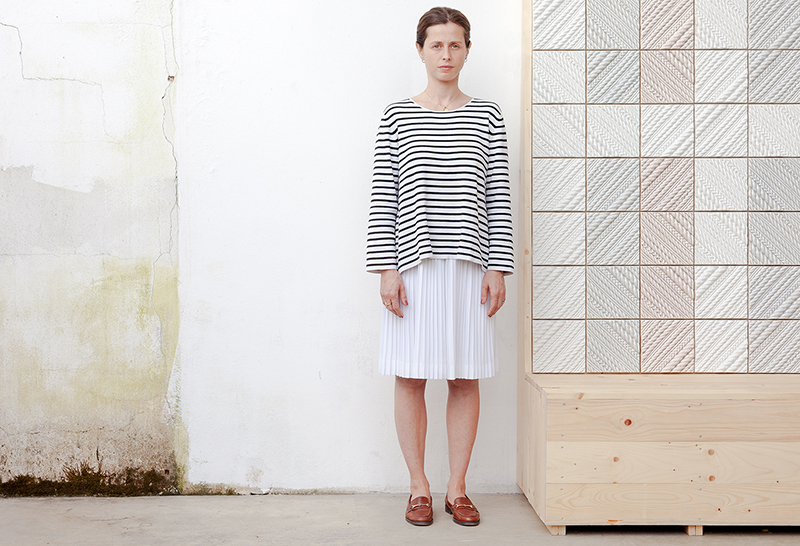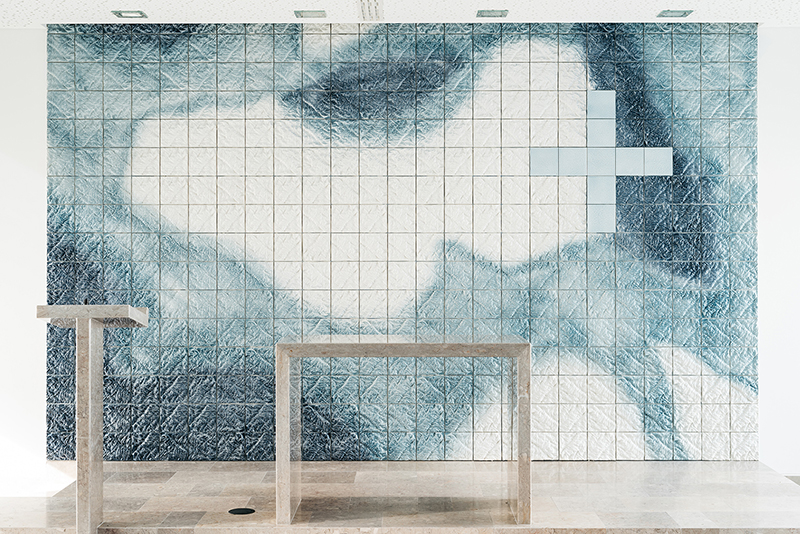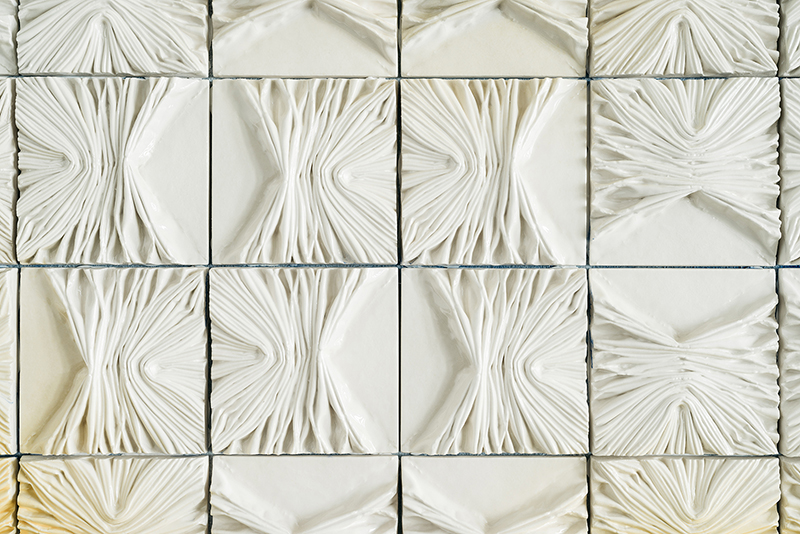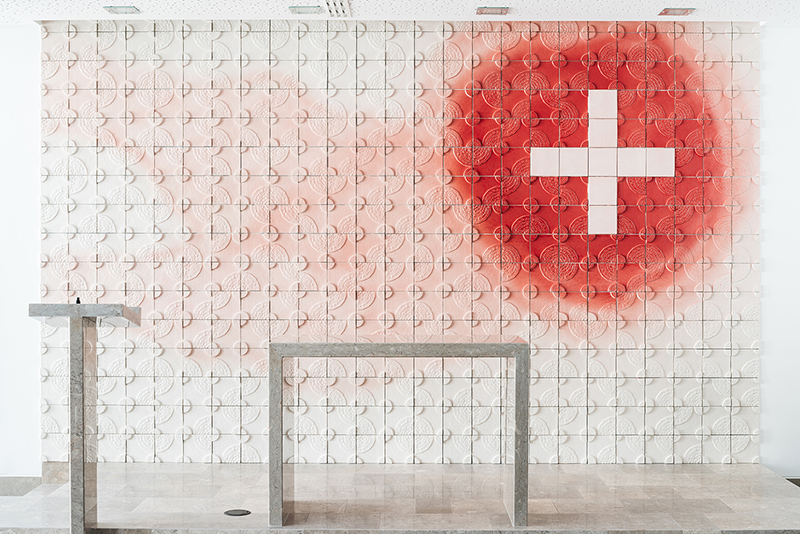In Conversation with…Candida Wigan of tex-tile with Jim Biddulph
Who ever said we should be bound to one career path? The beginning of the 21st century represents a time of the ‘portfolio career,’ of ‘life long learning,’ where the labeling and pigeon-holing of jobs seems ever increasingly absurd, particularly in the world of design.
Having left Lisbon to study for a Diploma in Textiles at Camberwell College of Arts at 18, Candida Wigan still had an itch to scratch. It’s one that would eventually lead her to found ceramic tile manufacturer tex-tile, although the way in which it came to fruition can hardly be described as conventional. After finishing at Camberwell she pursued a desire for exploring spatial awareness, going on to complete a BA in Interior and Spatial Design from Chelsea College of Arts. This deepened her curiosity and led her to enroll in the third year of the BA in Architecture at London Metropolitan University, where she realised a love for studying and transforming the full dimension of internal and external spaces.
Jobs followed, first at Souto Moura Architects in Porto and then Adjaye Associates in London, during which time she went on to complete a Diploma in Architecture at the Bartlett School of Architecture. Now residing back near Lisbon, geographically she’s gone full circle. But how did she make the leap to ceramic tiles? I caught up with her to find out about more the evolution of her career and why she loves continuing to try out new things. 
JB: You chose to study an array of different, albeit overlapping design disciplines and made massive progress as an Architect, so how did you come to working with ceramics?
CW: I have always had an interest in ceramics. When I was growing up I had ceramic lessons with this amazing artist and I now realise how influential she was on my work. Even then I remember working with ceramics and textiles together. However it was a series of events that led me to work with ceramics. I was working at Adjaye Associates in New York City and working on a competition for a house and he asked me to clad the building in tiles. It was around the same time that the Casa da Musica in Porto was completed.
JB: So the project became a turning point, a direct move to working in ceramics? Did you actually design the tiles used on the project?
CW: Well actually, no. I embarked on quite a thorough research project but ended up being disappointed by what I found and so we ended up changing the material. However, the process had quite a profound affect on me. In 2009 after my son was born, I took a step back and thought about my career and decided that I did not want to go back to work in an architectural practice. I started to break down what I really enjoyed about architecture and that was the material part of the process. At the same time someone that owns a small tile workshop outside Lisbon asked me to make a few tiles for them and so tex-tile started. I did eventually design tiles for Adjaye Associates, but it was for the Alara Concept Store. JB: You mentioned textiles already, and the name of your company as well the visual effect you create on the tiles very much references thread, yarns, rope and fabric, so what’s the relationship between the 2 material types?
JB: You mentioned textiles already, and the name of your company as well the visual effect you create on the tiles very much references thread, yarns, rope and fabric, so what’s the relationship between the 2 material types?
CW: I would say that it started as a bit of an accident. When I first went out to that workshop, I went with moulds made of metal, plastic, wood and fabric. And after a few test imprints on the clay I quickly realized that fabrics work extremely well. There is a plasticity and elasticity about both materials that isn’t so inherent amongst the others. What’s more, the clay can capture the range of detail that you get from fabric, as if creating a second skin. This is where the journey of making fabric moulds for clay surfaces began.
JB: And you’ve now got a number of different designs within your collection, so how do you go about designing new ones?
CW: I started off designing a range a year and that made sense, as there were many textures and fabrics that I wanted to explore. Since then, there have been a few textures that I have developed independently, but most of my work has been project based. Because of the nature of creating bespoke designs most of the new pieces have been quite different and varied, so in a way, I have used them as studies that I can develop further ranges from. JB: You mentioned fairly broad initial tests, and experimentation is clearly a part of your practice, but would you ever consider using different materials?
JB: You mentioned fairly broad initial tests, and experimentation is clearly a part of your practice, but would you ever consider using different materials?
CW: I always thought when I left my architectural job that I was going to start off with tiles and then I would go onto study other materials for architecture, but this pairing has been such a rich find. It does not mean to say that I have not thought that I could go down many other routes, using other materials, but the relationship between ceramics and textiles is so rich that I feel I have barely scratched the surface. That said, at some stage I would love to create a multidisciplinary practice that would focus on the exploration of multiple materials for architecture!
JB: And finally, what do you see the future of ceramic including? Any insights into new developments
CW: I think that there are some really interesting things out there, 3D ceramic extrusion, 3D printed objects, but to be honest I still think there is so much to explore with fabric composition and 3D mould making – plus, it’s a dying trade so I would like to explore it as much as possible! For more information visit www.tex-tile.org
For more information visit www.tex-tile.org




